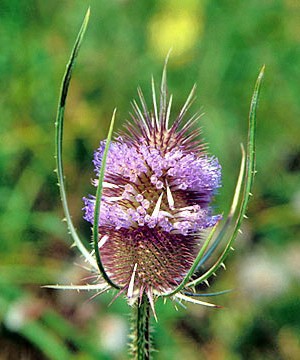
|
|
Teasel
- Dipsacus sylvestris
|
Teasel
- Dipsacus spp.
Dipsacus is a genus of flowering plant in the family
Dipsacaceae. The members of this genus are known as teasel or teazel or
teazle. The genus includes about 15 species of tall herbaceous biennial plants
(rarely short-lived perennial plants) growing to 1-2.5 m tall, native to
Europe, Asia and northern Africa.
Dipsacus
sylvestris is weed native of Europe, it is mostly seen along roadsides and
fencerows. Its generic name, sylvestris, insinuates that it grows in the
woods. However, you rarely see this plant in the woods, and again, more often it is seen in waste areas along
roadsides. The name teasel comes from the Old English, taesun, to tease.
Dipsacus is derived from the Greek word 'dipsakos' which means diabetes, and a common symptom of which is thirst
(Clark, 1998). The link between 'thirst' and the plant is apparently the water that sometimes accumulates at the base of the oppositely arranged and jointed
leaves.
Rain water can collect in this receptacle; this may perform the function of preventing
sap-sucking insects such as aphids from climbing the stem. The leaves are
lanceolate, 20-40 cm long and 3-6 cm broad, with a row of small spines on the underside of the
midrib.
It is in flower from July to
August, and the seeds ripen from August to October. The flowers are hermaphrodite
(has both male and female organs) and are pollinated by Bees. The plant is
self-fertile. It is noted for attracting wildlife.
Teasels are easily identified with their prickly stem and leaves, and the inflorescence of
purple, dark pink or lavender flowers that form a head on the end of the
stem(s). The inflorescence is ovoid, 4-10 cm long and 3-5 cm broad, with a basal whorl of spiny
bracts. The first flowers begin opening in a belt around the middle of the spherical or oval
flowerhead, and then open sequentially toward the top and bottom, forming two narrow belts as the flowering
progresses. The dried head persists afterwards, with the small (4-6 mm) seeds maturing in mid
autumn.
The seeds are an important winter food resource for some birds, notably the European
Goldfinch; teasels are often grown in gardens and encouraged on nature reserves to attract
them.
Teasels prefers light (sandy), medium
(loamy) and heavy (clay) soils and can grow in heavy clay soil. They
prefer acid, neutral and basic (alkaline) soils. They cannot grow in the
shade.
They require moist soil.
Teasels have been naturalised in many regions away from their native
range, partly due to the import of Fuller's Teasel for textile
processing, and partly by the seed being a contaminant mixed with crop
seeds. The Fuller's Teasel (the cultivar group Dipsacus fullonum Sativus
Group; syn. D. sativus) was formerly widely used in textile processing, providing a natural comb for
cleaning, aligning and raising the nap on fabrics, particularly wool. It differs from the wild type in having
stouter, somewhat recurved spines on the seed heads.
The bristly flower heads, matured and
dried, were used by
fullers to raise the nap on woollen cloth - to 'tease' it. Fuller's Teasel was cultivated from the small teasel to have
larger, stiffer and spinier flower heads specifically for the job.
The heads were attached to a wheel, spindle or cylinder, which was spun against the cloth to raise the
nap. The spines were more 'elastic' that metal, which was an advantage. If an obstruction was
encountered, the spines would break rather than tear the cloth.
Although metal brushes have now replaced teasel, it is still used by some who weave wool by
hand, being used to separate and straighten the tangled fibres before
spinning. They can also still be found used in the manufacture of billiard table
cloths, the coverings of tennis balls, piano felts, the upholstery and roof linings of
Rolls-Royces, and Guardsmen's tunics.
The water that collects in the leaves has been claimed to have marvellous cleansing
properties, and is considered a good eyewash. However, observation shows that insects often drown in these pools of rainwater and
dew. It could be for this reason that the water was also recommended to be a cure for warts and
freckles.
A root tea was once used as a diuretic, and to help stimulate the
appetite.
Teasel is little used in modern
herbalism, and its therapeutic effects are disputed. Traditionally it has been used to treat conditions such as
warts, fistulae (abnormal passages opening through the skin) and cancerous
sores. The root is diaphoretic, diuretic and stomachic. A homeopathic remedy is made from the flowering
plant. It is used in the treatment of skin diseases.
A blue dye obtained from the dried plant is an indigo substitute. It is water
soluble. A yellow is obtained when the plant is mixed with alum.
Teasels are also occasionally grown as ornamental
plants, and the dried heads are used in floristry.
They are popular with dried flower arrangers.
Source:
http://en.wikipedia.org/wiki/Dipsacus
http://www.pfaf.org/database/plants.php?Dipsacus+fullonum
http://oregonstate.edu/dept/nursery-weeds/weedspeciespage/
teasel/common_teasel_Dipsacus_sylvestris_page.html
http://www.bbc.co.uk/dna/h2g2/A4185443
